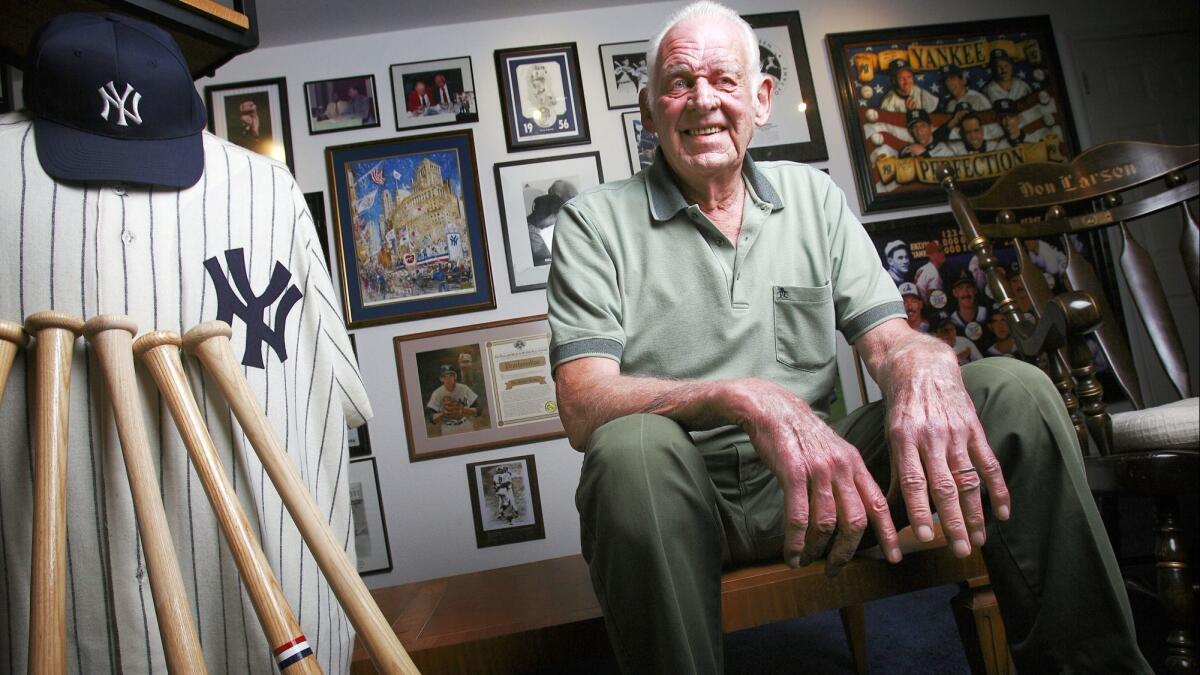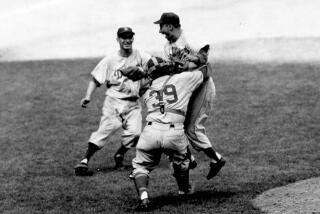Don Larsen, only pitcher to throw a perfect game in World Series, dies at 90

- Share via
Don Larsen, who on a glorious fall afternoon in New York in 1956 pitched the only perfect World Series game in history, died Wednesday of esophageal cancer in Hayden, Idaho, said his agent Andrew Levy. Larsen was 90.
With the Subway Series between the New York Yankees and the Brooklyn Dodgers tied at two games each, Larsen retired all 27 Brooklyn batters he faced in Yankee Stadium on that Monday afternoon of Oct. 8, allowing no hits and no walks, while his Yankee teammates backed him with no errors — and a few defensive gems — in a 2-0 victory. The Yankees went on to win the Series, four games to three.
Larsen, a starter-reliever for the Yankees, seemed an unlikely choice to pitch the pivotal fifth game against the defending champion Dodgers.
At 27, he’d spent part of the previous season with the minor league Denver Bears and had also developed a reputation as a carouser — a reputation he shared with teammates Mickey Mantle and Billy Martin — and had polished off spring training by wrapping his car around a utility pole one morning at 4. To his teammates, he was Gooney Bird.
Although he had produced four impressive late-season victories for the Yankees on his way to an 11-5 record in 1956, he was only the fourth starter in a five-man rotation that included 19-game winner Whitey Ford, 18-game winner Johnny Kucks and 16-game winner Tom Sturdivant. Larsen, in fact, had pitched nearly as often in relief, 18 times, as he had started, 20 times.
Larsen had started Game 2 of the World Series at Ebbets Field in Brooklyn and, and although he wasn’t tagged for the loss, he was responsible for four runs as the Yankees blew a six-run lead in the second inning, giving the Dodgers new life on their way to a 13-8 victory.
So when Larsen walked into the clubhouse before Game 5 and found a baseball in one of his game spikes — manager Casey Stengel’s way of telling a pitcher he’d be starting that day — he was as surprised as everyone else.
“I didn’t think I’d be starting again,” Larsen recalled. “I thought I’d be in the bullpen.”
Instead, he pitched the game of his life.

Yankees pitcher Don Larsen completes his perfect game against the Brooklyn Dodgers in the 1956 World Series.
He’d been wild in his previous start, walking four of the 10 batters he faced, but this time around, using the no-windup delivery he’d adopted earlier in the season, he worked with laser-like accuracy, throwing only 97 pitches, striking out seven, going to a three-ball count against only one batter, Pee Wee Reese, in the first inning.
“I never had such good control in my life,” Larsen recalled often, telling writers he’d relied mostly on his fastball, with a few curves and sliders thrown into the mix, and that catcher Yogi Berra had called a brilliant game, which Larsen had followed precisely, pitch by pitch.
The Yankees, meanwhile, were having their problems with Sal Maglie, Brooklyn’s starter who was pitching a five-hitter. Mantle got to him for a solo home run in the fourth inning and the Yankees got another run in the sixth on a single by Andy Carey, a sacrifice bunt by Larsen and a single by Hank Bauer.
It was customary that no one would talk about a no-hitter in progress, that teammates and coaching staff would virtually ignore the pitcher, lest they jinx him. So when his teammates stopped talking to him, Larsen realized what was happening.
He turned to Mantle in the seventh inning and said, “Hey, Mick, look at the scoreboard. Only a couple more innings.”
Muttering, Mantle spun on his heels and walked to the other end of the dugout.
It was, as Larsen remembered, mighty quiet and mighty lonesome.
If his teammates weren’t talking to him, though, they were certainly helping him through some close calls. A line drive by the Dodgers’ Jackie Robinson in the second inning bounced off third baseman Carey’s glove but caromed over to shortstop Gil McDougald, who threw out Robinson at first by half a step.
Then Mantle saved the day in the fifth, when Larsen hung a 2-2 slider for Gil Hodges, who hit it to “Death Valley,” the deepest part of left-center field.
Hodges’ drive would have been a home run in most other parks — one of them being Ebbets Field — but Mantle was fast, Yankee Stadium was spacious and Hodges was out when Mantle reached up and backhanded the ball on the dead run.

The next hitter, Sandy Amoros, whacked a fastball into the lower right-field stands, but it curved foul at the last second. Then in the eighth, Carey picked Hodges’ low liner off his shoe tops.
Carl Furillo opened the ninth inning for the Dodgers, fouling off four consecutive pitches before flying out. Roy Campanella hit an inside pitch long but foul, then tapped weakly to Martin at second.
As the announcement was made that Dale Mitchell, a midseason Dodgers acquisition with a .314 major league batting average, would pinch-hit for Maglie, Larsen turned to the outfield, took off his cap, wiped the sweat from his brow with his sleeve, then turned to face Mitchell.
Larsen ran the count to 1-2, then threw a fastball, maybe a little high, maybe a little outside. Mitchell started to swing, checked it, then stood unbelieving as umpire Babe Pinelli, working behind the plate for the last time before retirement, called strike three.
“I was stunned for a moment,” Larsen told Newsday in 1996. “Then I saw Yogi coming at me — it’s the most excited I ever saw him. He jumped into my arms and soon I was mobbed. ... I knew I’d pitched a no-hitter, but I didn’t know it was a perfect game until I got to the clubhouse and the writers told me.”
Larsen never came close to perfection again — he retired with an 81-91 record, having pitched for eight teams in his 14-season big league career — but he never tired of reliving his big day.
“I think of it every day,” he told anyone who asked. “I can’t help it. It was the best thing that ever happened to me.”
Born Donald James Larsen in Michigan City, Ind., on Aug. 7, 1929, he moved with his family as a teenager to San Diego, where he went to Point Loma High School, earning a reputation as a really good basketball player, a pretty good baseball player and an indifferent student. He signed with the St. Louis Browns after high school, moved on with them when they became the Baltimore Orioles, then went to the Yankees in an 18-player deal in 1955.
After retiring in 1967, he worked as a salesman for a San Jose paper goods company for 24 years, then retired again, to Hayden in the Idaho panhandle, not far from Coeur d’Alene.
Kupper is a former Times staff writer.
More to Read
Start your day right
Sign up for Essential California for the L.A. Times biggest news, features and recommendations in your inbox six days a week.
You may occasionally receive promotional content from the Los Angeles Times.






